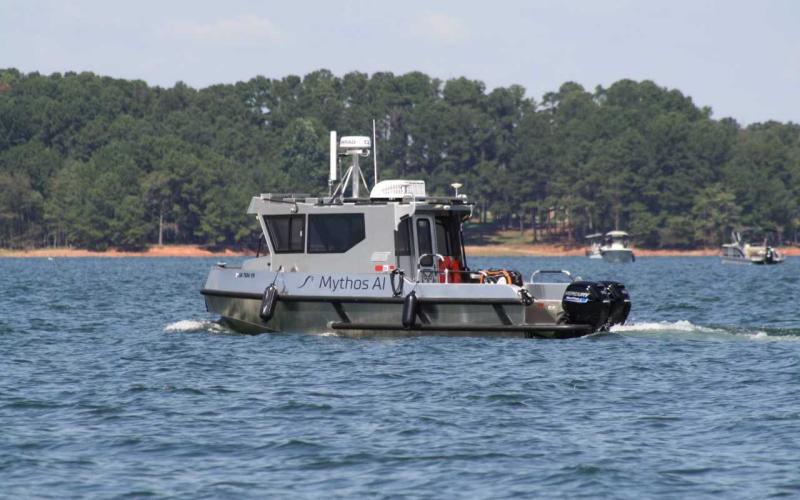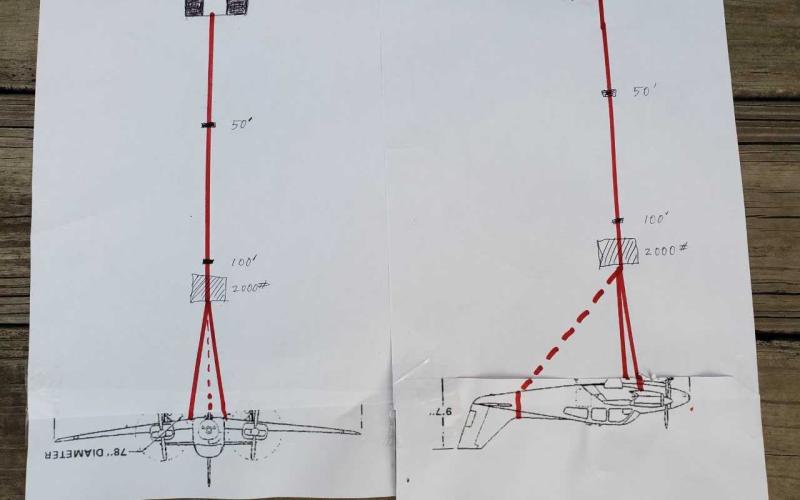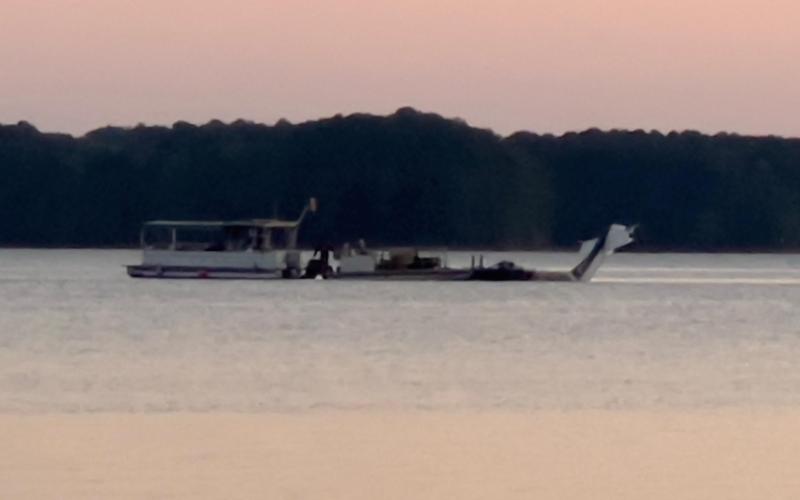With local, state and federal officials assisting, divers on Thursday, Sept. 15 were able to recover the body of a pilot whose double-engine plane crashed into Lake Hartwell and sank approximately 121 feet five days prior.
At about 6 p.m., after close to eight hours of lifting the plane about 100 feet and moving it to a safe location away from underwater trees, divers from Elbert County were able to bring to surface the body of Todd Carrell, 55, of North Port, Florida.
Hart County Sheriff Mike Cleveland said Carrell, the owner of the six-seat Beechcraft 55 Baron, was turned over to the Hart County Coroner’s Office.
Hart County Coroner Mike Adams said on Tuesday, Sept. 20 that Carrell’s body was sent to Decatur for an autopsy and he was awaiting results.
Secondary to the pilot’s recovery was the raising and recovering of his plane by specialists from the Lake Jocassee (South Carolina) area in conjunction with the National Transportation Safety Board. The full operation, primarily orchestrated by Bill Routh’s Upstate Dock Repair and Diving Specialists, was completed at about 2 a.m., according to Cleveland.
“The plane was pretty much intact,” Cleveland said. “Of course it had a hole torn in the fuselage. But the wings were intact. One motor was completely intact and another was just barely holding on by the cables. All-in-all, the plane was in good shape.”
NTSB officials deconstructed the plane, cutting the wings off, before pulling it aboard a flat-bed trailer with a crane and driving it to a NTSB regional office in Atlanta for investigation.
Keith Holloway, media relations officer for NTSB said Monday, Sept. 19 that information on what may have caused Carrell’s accident was limited.
“It is important to note that it is very early in the investigation. NTSB does not determine cause in the early part of the investigative process,” Holloway said. “This is considered the fact-gathering phase of the investigation.”
Holloway went on to say the preliminary report may take about 10-15 business days, while a “typical NTSB investigation can take 12-24 months to complete and determine cause.”
Cleveland said Monday, “Their complete investigation, I think, is going to be with the instrument panels and the data that’s always kept during every second that the plane is going.”
Carrell’s plane crashed Saturday, Sept. 10 into Lake Hartwell near Long Point Recreation Area in Hartwell at about 12:42 p.m. Carrell, the pilot and only passenger, was assumed dead after observation of the scene by an underwater remote controlled vehicle from the Oconee County, South Carolina Dive team. The Federal Aviation Administration identified the aircraft as registered to Carrell, although Hart County officials couldn’t officially confirm his identity until he was recovered by Elbert County divers four days later.
Efforts by the Oconee divers to recover Carrell’s body in the first two days after the accident were unsuccessful.
“Due to the depth of the water and the plane’s position, divers could not remove the person,” Cleveland said.
The plane was upside down and entangled in a tree, he said.
“The National Transportation Safety Board (NTSB) was contacted to find resources to lift the plane so the person could be extricated,” Cleveland said. “The NTSB along with the plane’s insurance company contracted with Atlanta Air Recovery and Bill Routh of Upstate Dock Repair and Diving Specialists from Lake Jocassee to remove the plane from the water.
Agents confirmed that Carrell’s plane took off from Punta Gorda, Florida at 9:40 a.m. Sept. 10 with a flight plan to arrive in Anderson, South Carolina around 12:40 p.m. A time lapse on the flight tracking site FlightAware shows the pilot’s plane arriving near Anderson Regional Airport, then backtracking and circling a few times over the lake before the time lapse ends.
Anderson Regional Airport senior administrative assistant Kathy R. Cleveland said pilots communicate with Greer Approach before landing. Communications between approach and pilots are logged by the FAA. The Hartwell Sun filed a Freedom of Information Act request with the FAA for communication between Carrell and Greer. The request was not answered by press time Wednesday.
“I am told that if someone misses their approach, they usually instruct them to circle back around and try again,” Kathy Cleveland said. “Unfortunately, on a cloudy/rainy day, it can be easy for a pilot to get spatially disoriented.”
Plane Recovery
Among those on hand for a roughly 18-hour operation on Sept. 15, were agents from the NTSB, Hart County Sheriff’s Office, Georgia State Patrol, Georgia Department of Natural Resources and divers from Elbert County as well as the Upstate Dock Repair and Diving Specialists.
Routh’s specialists largely conducted the plane’s lift using a chain that was attached to the plane in three places. Routh was part of a four-man team of divers that included son Tripp Routh, grandson Leonard Routh and longtime professional John Baker.
The operation was Routh’s third plane recovery.
“Basically what we did prior to showing up on Thursday (Sept. 15) — On Wednesday, I went and took measurements from an identical aircraft that was parked at an airport up in Greenville. And from the measurements I took from that aircraft, we built a harness to attach to the one on the bottom of the lake so that we didn’t have to go down and construct something. It was already constructed,” Routh said.
“Now, we’re talking about something as simple as three, three-inch straps. But we needed to know exactly how we were going to rig those in such a way so that that aircraft comes up flat because we were concerned about losing contents. We wanted to recover the aircraft with the pilot so we had to make sure that we lifted this aircraft just like it was sitting on the bottom flat.”
Routh said since the plane was laying upside down underwater, the plane was recovered the same way to avoid over-disturbing the plane.
“In taking the measurements that we did, all of our straps were already pre-set to the right length,” he said. “All we had to do was connect them to the aircraft or go around and choke each wing — that’s the rigging term. We had to put the straps on the wings and a third strap around the fuselage just forward of the tail section.
“We had a three-point harness that we built prior to showing up at the lake that day. Everything was already built; everything was already planned for us to just lower this entire chain.”
Routh said the chain was 130 feet long and everything attached to the single chain all the way up to the winch on the group’s barge.
“That chain suspended from the barge to the aircraft. When we dove to the bottom, the first thing we did was secure that chain to one of the landing gear of the plane so now, our barge was chained to the aircraft. Once that was established we started attaching the three straps, one to each wing and one to the fuselage,” he said.
A 2,000 lb. flotation device was also attached to the rig to help with the plane’s lift, he said. Due to the pre-planning, the divers only spent about 24 minutes attaching the aircraft to the lift.
“Once we had everything attached to the aircraft, we decided before we started the lift, we were going to take a break because at that point we (divers) didn’t need to be at 120 feet anymore,” Routh said.
The divers took a break for decompression around noon.
“Since we had already spent roughly 25 minutes on the very bottom, that put us in decompression. So we made our call to come out of the water and do our decompression on the way up and do a one-hour surface interval, which gave us the time to go back in the water to start the lift of the aircraft without having a decompression obligation,” Routh said. “In other words, for the second dive, at any point, we could have gone to the surface without stopping.
“On the first dive, we had 15 minutes of decompression to complete before we could go to the surface. It just didn’t make any sense to us to push it. We had the plane rigged; that was the objective of the first dive. And so, the second dive, we went into the water and lifted the aircraft.”
The deep divers used trimix air to combat the “martini effect,” Routh said.
“The helium in the gas that we were breathing gives us a super-clear head at deep depths because one of the issues divers run into is what we call narcosis. And once you get to 100 feet, it’s like drinking a martini,” Routh said. “So you’re loopy from breathing air. It’s the nitrogen in the air that causes this loopiness or narcosis. So in order for us to do what we need to do, we have to have helium in our mix, and that reduces the amount of nitrogen in the gas we’re breathing.”
Routh’s team orchestrated a three-stage lift of the plane.
“We picked it up 50 feet, which cleared the trees. Then we secured the chain and we lowered our cable and we picked it up 50 more feet,” he said. “Then we lowered the cable and picked it up the final 20 feet. When we finished the lift, the plane was approximately 30 feet below the surface.”
Then began a very long tow.
“What we were told is that we had 30 feet of clearance all the way to where they wanted to do the [body’s] extraction,” Routh said. “We ran into several trees that were shallower than 30 feet. The plane ran into one tree and got stuck in it. We had to back up and get out of the tree.”
Routh said one of the engines was dangling from the plane and getting stuck in trees.
“It just took us a while to get over where they wanted us to secure the barge so they could do the extraction. Once that extraction was complete — and I think they only took 20-to-30 minutes to complete that — then we went in the water and brought the airplane closer to the surface. It was only at about 10 feet of water on that final lift.”
Even though Routh was responsible for recovering the plane in good shape, his efforts were tantamount to recovering the pilot and eventually returning him to his family.
“We came there to help the family resolve the issue and return their loved one. That was our primary goal that day,” Routh said. “The airplane was just part of that goal. But the goal was to return that pilot to his family.”
Hart County Sheriff Mike Cleveland said he was impressed by Routh’s operation.
“I hate for the family that it took so long but I am grateful to that Lake Jocassee crowd for getting down here and getting the job done in one day,” Cleveland said. “They were very professional and knew what they were doing. We also appreciate all the other agencies. We’ve got to thank Elbert County, Oconee County, State troopers, DNR. The list goes on and on.
“We appreciate the prayers and the food that was brought down there. All that goes a long way.”



